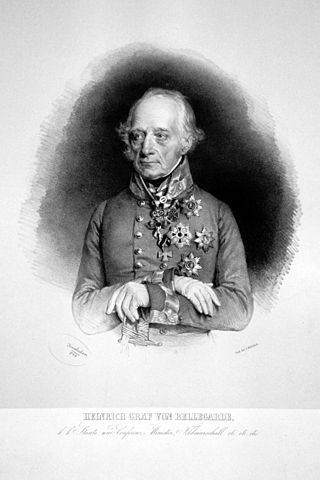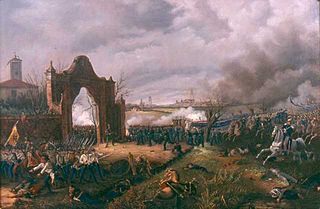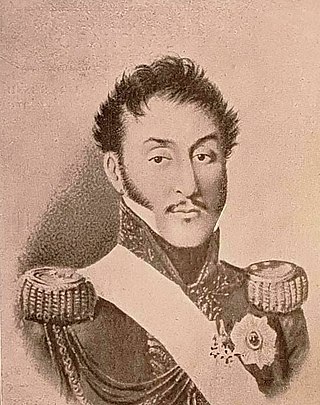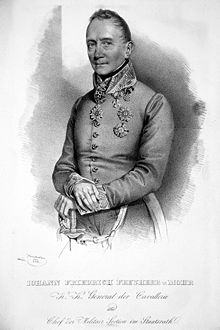
The War of the Third Coalition was a European conflict lasting from 1805 to 1806 and was the first conflict of the Napoleonic Wars. During the war, France and its client states under Napoleon I and its ally Spain opposed an alliance, the Third Coalition, which was made up of the United Kingdom, the Austrian Empire, the Russian Empire, Naples, Sicily, and Sweden. Prussia remained neutral during the war.

The Battle of Jemappes took place near the town of Jemappes in Hainaut, Austrian Netherlands, near Mons during the War of the First Coalition, part of the French Revolutionary Wars. One of the first major offensive battles of the war, it was a victory for the armies of the infant French Republic, and saw the French Armée du Nord, which included many inexperienced volunteers, defeat a substantially smaller regular Austrian army.

Joachim Murat was a French Army officer and statesman who served during the French Revolutionary and Napoleonic Wars. Under the French Empire he received the military titles of Marshal of the Empire and Admiral of France. He was the first Prince Murat, Grand Duke of Berg from 1806 to 1808, and King of Naples as Joachim-Napoleon from 1808 to 1815.

The Neapolitan War, also known as the Austro-Neapolitan War, was a conflict between the Napoleonic Kingdom of Naples and the Austrian Empire. It started on 15 March 1815, when King Joachim Murat declared war on Austria, and ended on 20 May 1815, with the signing of the Treaty of Casalanza. The war occurred during the Hundred Days between Napoleon's return from exile and before he left Paris to be decisively defeated at the Battle of Waterloo. The war was triggered by a pro-Napoleon uprising in Naples and ended with a decisive Austrian victory at the Battle of Tolentino, after which Bourbon monarch Ferdinand IV was reinstated as King of Naples and Sicily. However, the intervention by Austria caused resentment in Italy, which further spurred on the drive towards Italian unification.

Count Heinrich von Bellegarde, Viceroy of Lombardy-Venetia, of a noble Savoyard family, was born in Saxony, joined the Saxon army and later entered Habsburg military service, where he became a general officer serving in the Habsburg border wars, the French Revolutionary Wars and the Napoleonic Wars. He became a Generalfeldmarschall and statesman.

The Battle of Tolentino was fought from 2–3 May 1815 near Tolentino, Kingdom of Naples in what is now Marche, Italy: it was the decisive battle in the Neapolitan War, fought by the Napoleonic King of Naples Joachim Murat to keep the throne after the Congress of Vienna. The battle occurred during the Hundred Days following Napoleon's return from exile and, like the Battle of Waterloo, resulted in a decisive victory for the Seventh Coalition, leading to the restoration of the previous Bourbon king, Ferdinand I.

The First Italian War of Independence, part of the Italian Unification (Risorgimento), was fought by the Kingdom of Sardinia (Piedmont) and Italian volunteers against the Austrian Empire and other conservative states from 23 March 1848 to 22 August 1849 in the Italian Peninsula.

The Battle of the Panaro was a victory for King Joachim Murat's Neapolitan forces over a smaller Austrian force under Frederick Bianchi on 3 April 1815 early in the Neapolitan War. This defeat on the banks on the Panaro River, just south of Modena forced the Austrians to retreat behind the Po River.
The Battle of Carpi took place during the Neapolitan War between a brigade of Neapolitan soldiers under the command of Guglielmo Pepe and an Austrian force under the command of Baron Frimont. The battle took place in the town of Carpi and resulted in an Austrian victory, with the Neapolitans being driven from the town.
The Battle of Occhiobello was fought on 8 April – 9 April 1815 and was the turning point of the Neapolitan War. Joachim Murat, King of Naples was repulsed by an Austrian force under the command of Johann Frimont whilst trying to cross the bridge over the Po River at Occhiobello. Following the battle, the Austrians would not lose an engagement for the remainder of the war.
The Battle of Ronco took place during the Neapolitan War on 21 April 1815 in the village of Ronco, just south of Forlì. The main Neapolitan army, retreating following the disaster at the Battle of Occhiobello, was being pursued by an Austrian corps under the command of Adam Albert von Neipperg. The Neapolitans, commanded by their king, Joachim Murat, turned to check the Austrians at the Ronco River. The Neapolitans rear guard was defeated by a smaller advanced Austrian force, compelling Murat to retreat further south to the Savio River. The Austrians suffered light casualties, whereas nearly 1,000 Neapolitans were killed or wounded and more deserted Murat altogether.

The Battle of Cesenatico was a minor battle in the Neapolitan War that took place on 23 April 1815 in the town of Cesenatico on Adriatic coast.

The Battle of Pesaro was a minor battle in the Neapolitan War that took place on 28 April 1815 in the town of Pesaro.

The Battle of Castel di Sangro was a minor battle in the Neapolitan War that took place on 13 May 1815 in the town of Castel di Sangro in central Italy. The battle resulted in the Neapolitan force being routed.

The Battle of San Germano was the final battle in the Neapolitan War between an Austrian force commanded by Laval Nugent von Westmeath and the King of Naples, Joachim Murat. The battle started on 15 May 1815 and ended on 17 May, after the remaining Neapolitan force was routed at Mignano.

Johann Josef Cajetan Graf von Klenau, Freiherr von Janowitz was a field marshal in the Habsburg army. Klenau, the son of a Bohemian noble, joined the Habsburg military as a teenager and fought in the War of Bavarian Succession against Prussia, Austria's wars with the Ottoman Empire, the French Revolutionary Wars, and the Napoleonic Wars, in which he commanded a corps in several important battles.

The Battle of Ostrach, also called the Battle by Ostrach, occurred on 20–21 March 1799. It was the first non-Italy-based battle of the War of the Second Coalition. The battle resulted in the victory of the Austrian forces, under the command of Archduke Charles, over the French forces, commanded by Jean-Baptiste Jourdan.
The Armistice of Treviso was a ceasefire signed on 16 January 1801, in Treviso, Italy, between French General Guillaume Brune and the Austrians during the War of the Second Coalition. Brune had defeated Austrian General Heinrich von Bellegarde at the Battle of Pozzolo on 25 December 1800 and drove Generals Josef Philipp Vukassovich and Johann Ludwig Alexius von Loudon from a succession of defensive positions in the mountains. Bellegarde retreated to Treviso and prepared for its defence but agreed to a ceasefire. Under the terms the Austrians ceded many towns in northern Italy but retained Mantua. Napoleon desired the city, which was within striking distance of a French force, and as a result was displeased with Brune, who had promised that Mantua would form part of any armistice deal. However, following French victories in Tuscany and Germany, the French were able to negotiate the ceding of Mantua as part of the Treaty of Lunéville of 9 February 1801.

The Army of the Kingdom of Naples was the land force of the Kingdom of Naples. It was in service from 1806 to 1815, reborn from the Army of the Two Sicilies after the French invasion of Naples. It served alongside Napoleon’s Grande Armée in various campaigns of the Napoleonic Wars, until its final demise in the Neapolitan War.

The Italian campaign of 1813–1814 was the series of military operations of the War of the Sixth Coalition, mainly in Northern Italy, that pitted the French Empire and the Kingdom of Italy against Coalition forces led by Austria and Britain. It represented the last stage of the so-called "French period", beginning with the Italian campaign of 1796–1797, in which a French and an Austrian army confronted each other for control of the Italian peninsula. The Austro-Neapolitan War of 1815 was essentially a clash between only Italians and Austrians.
















